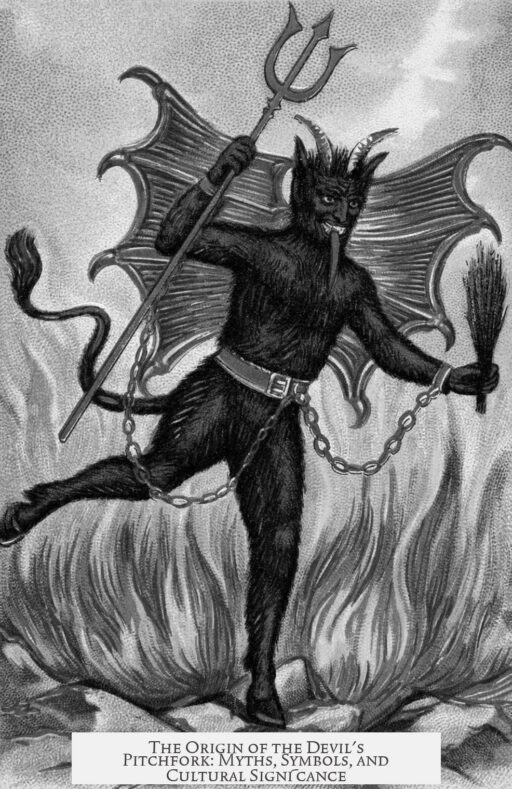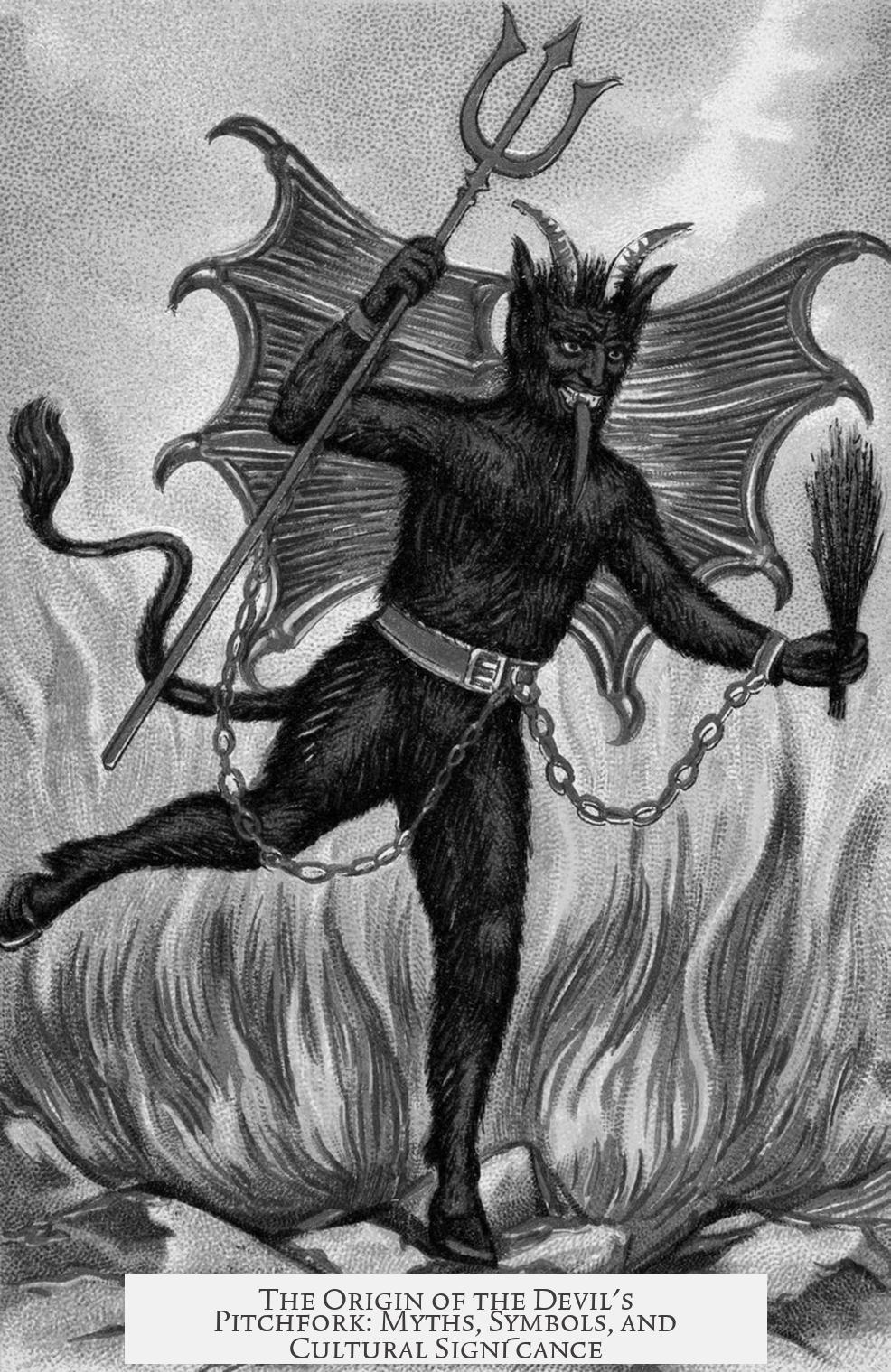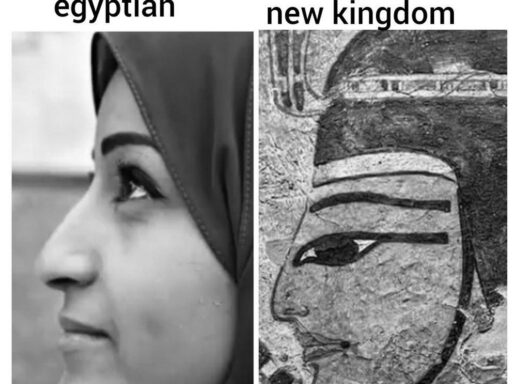The Devil is often portrayed with a pitchfork because this image evolved during the early medieval period, combining classical symbolism, agrarian life, and moral associations held by medieval ecclesiastics. This depiction does not come from biblical texts but from a complex interaction of cultural influences and the daily environment of monks and clergy who shaped the devil’s iconography.
Early images of the Devil with a pitchfork appear in the 10th century, notably on Muiredach’s High Cross in Ireland. This carving shows the Devil driving souls toward hell with a pitchfork-like implement. This is one of the first visual evidences linking the Devil to this tool. The pitchfork serves as a symbol of power and control, herding souls away from salvation.
According to historian Jeffrey Burton Russell, the Devil’s “pitchfork” partly derives from the classical trident, such as the one carried by the Greek god Poseidon. The ancient trident symbolized control over three realms: earth, air, and sea. Early Christians may have inherited this symbol and adapted it to represent the Devil’s authority in evil. However, no direct historical or biblical confirmation exists for this connection, and it remains a theoretical link rather than a proven one.
Russell also points out that the Devil’s pitchfork incorporates elements from various ancient images related to death and punishment. For example, the mallet of Charun, a figure from Roman mythology who presided over the underworld, reflects instruments associated with torment or death. These associations influenced medieval artists crafting the Devil’s terrifying image.
More than these classical roots, the pitchfork’s form corresponds closely with the common agricultural tool familiar to medieval monastic communities. Monks lived in rural settings surrounded by farming activities. Daily life involved observing implements like pitchforks used to lift hay or move manure. The three-pronged pitchfork was a practical innovation after 800 CE in northern Europe, differing from the Roman two-pronged designs.
When Christian ecclesiastics sought ways to visualize the Devil as a physical being symbolizing evil on earth, they naturally drew on what surrounded them. The pitchfork was an easily recognizable tool, linked to peasantry and rural labor. This connection was compelling because the Devil was often portrayed as opposing the “good” upper classes and clergy, who did not engage in manual labor.
The pitchfork also acquired a social and moral symbolism. In medieval society, the wealthy and ‘good’ were contrasted with the poor and laborers, who were viewed with suspicion and associated with vice or immorality by the ruling classes. The pitchfork, as a farmer’s tool, became a symbol of this “bad” morality. By giving the Devil a pitchfork, artists emphasized his association with the base, earthly, and corrupt.
An additional biblical reference indirectly supports the pitchfork imagery. John the Baptist’s vision describes a “winnowing fork” in his hand to separate wheat from chaff (Matthew 3:12, Luke 3:17). This agricultural tool symbolizes divine judgment and separation of the righteous from the wicked. Medieval artists may have drawn on this imagery, linking the pitchfork to the function of sorting souls, reinforcing its symbolic power.
In summary, the Devil’s pitchfork emerges from intertwining sources:
- Classical legacy of the trident as a symbol of power.
- Instruments connected to death and torment in ancient mythology.
- The agricultural life and tools familiar to monastic artists and writers.
- Social-moral symbolism attaching manual labor and the pitchfork to evil or “bad” morality from the perspective of medieval elites.
- Biblical imagery of winnowing forks used in divine judgment.
The pitchfork is a visual shorthand created in the medieval period. It symbolically expresses the Devil’s role as a tormentor and herder of souls. Rooted in real-world implements known to Christians, the image integrates classical motifs and social attitudes of the time. No direct Biblical description supports it; rather, it reflects medieval creativity and symbolic language.
Key Takeaways:
- The Devil’s pitchfork first appears in 10th-century iconography, such as Muiredach’s High Cross.
- Jeffrey Burton Russell traces it partly to the ancient trident, a symbol of power.
- Medieval monastics used everyday farming tools as inspiration for visualizing the Devil.
- The pitchfork symbolically linked to poor peasants, who were associated with “bad” morality.
- Biblical imagery of the winnowing fork indirectly influenced this symbolism.
- The pitchfork is a medieval invention with no direct Biblical or early ecclesiastical textual basis.
Why is the Devil Often Portrayed with a Pitchfork?
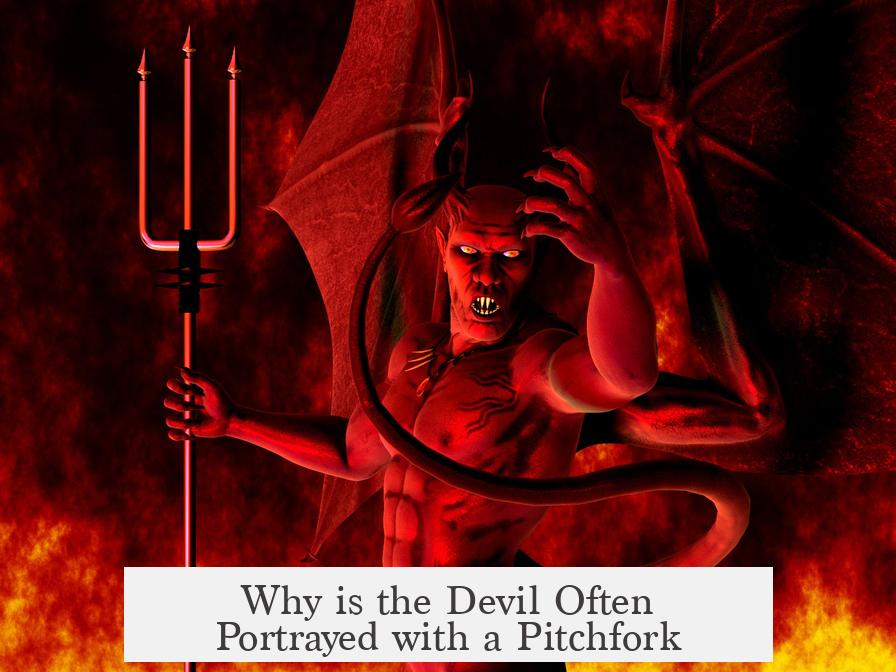
Simply put, the Devil is often portrayed with a pitchfork because medieval Christian artists and monks drew inspiration from their everyday agrarian world, using the pitchfork as a vivid symbol to “herd” souls into damnation, blending rural life with spiritual terror. No, it’s not just a random creepy choice! This image, now iconic, is a fascinating mix of cultural, religious, and social influences that evolved most notably in the early medieval period. Buckle up, because the story behind the Devil’s pitchfork is a juicy cocktail of history, symbolism, and a pinch of ecclesiastical imagination.
Let’s explore how this pronged implement became the Devil’s weapon of choice, and why it stuck around for centuries. Spoiler: it’s not because Satan worked in a barn.
Imaginary Devils: How Medieval Minds Made Evil Visible
Before the pitchfork-wielding Devil strolled the pages of medieval manuscripts or the faces of cathedral carvings, Satan was mostly an abstract concept. The Bible — surprise! — never describes the Devil with horns, cloven hooves, or a pitchfork. Those are later inventions.
During the “early middle ages” (roughly post-800 CE), a shift happened. As Christianity deepened its roots across Europe, the Devil transformed from an invisible force of evil into a real, tangible character. Ecclesiastics and monks, deeply influenced by the world around them, began giving Satan a physical form to make him more frightening and real to believers. This process, called materialization, gave rise to the now-famous horned and hooved image—complete with the dreaded pitchfork.
Why? Because if you want to scare people into good behavior, you better show them something concrete to dread. The Devil became a figure who stalked the earth with tools in hand, not just a shadowy menace lurking offstage.
The Pitchfork vs. The Trident: Confusing Ancient Symbols
You might wonder: “Isn’t the pitchfork just a fancy fork?” Well, maybe not so fancy. Scholars like Jeffrey Burton Russell have suggested that the pitchfork in the Devil’s hand actually derives from the ancient trident. This was the three-pronged weapon of Poseidon (god of the sea), symbolizing dominion over earth, air, and water. The trident also connected with death and torment — think of the mallet of Charun, a grim reaper figure in classical mythology.
The problem? This idea has weak evidence. There is no direct historical or biblical proof connecting Poseidon’s trident with the Devil’s pitchfork. No medieval texts or church fathers made this explicit link, nor do we have transitional art bridging this 1000-year gap between classical mythology and medieval Christian iconography.
So, if you were picturing Satan surfing the waves with a trident, hold that thought. Instead, the pitchfork as we know it likely took a different route—one firmly rooted in everyday medieval life rather than classical myths.
Monks, Fields, and Forks: The Real Story Behind the Devil’s Pitchfork
Here’s where things get fun. The daily life of medieval monks was dominated by agriculture. Life in monasteries meant tending fields, stacking hay, mucking barns, and all that rural grind. The pitchfork was omnipresent—slung on shoulders, leaning against walls, a common, utilitarian tool of the day.
Imagine monks imagining the Devil going around herding souls the way farmers herd crops or cattle. What better symbol than the pitchfork, the most familiar and practical tool used in their immediate environment? The Devil’s pitchfork appeared after roughly 800 CE, crafted by monks and bishops imagining the devil’s earthly, physical role.
This theory gains more weight when we consider Muiredach’s High Cross, a remarkable 10th-century Irish monument. It depicts the Devil using a pitchfork to herd souls away from Jesus and into damnation. Monastic artists weren’t pulling this out of thin air. They were making spiritual warfare real—instrumentalizing the tools they knew and saw daily.
The Winnowing Fork in Scripture: A Biblical Hint?
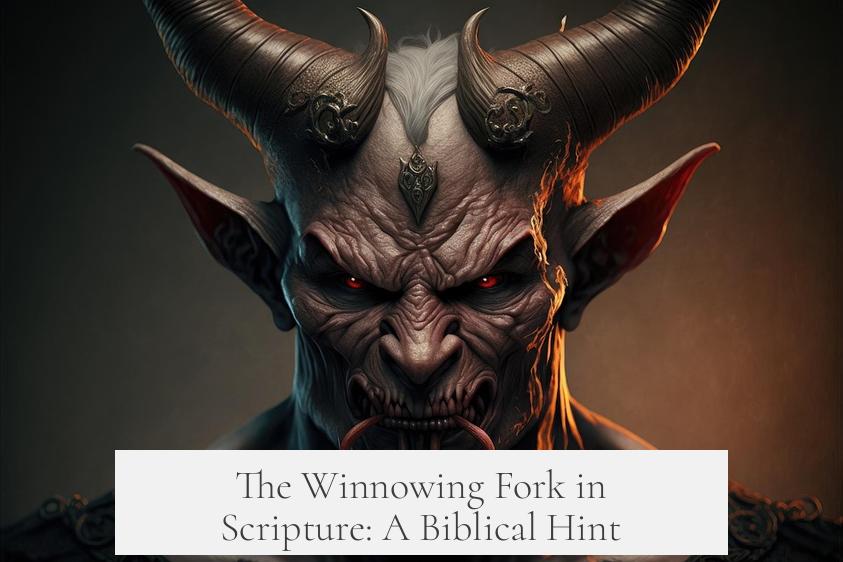
There is a possible indirect biblical influence, too. John the Baptist describes a “winnowing fork” in his apocalyptic vision: “His winnowing fork is in his hand, and he will clear his threshing floor, gathering his wheat into the barn and burning up the chaff with unquenchable fire” (Matthew 3:12, Luke 3:17). Though not the same as a pitchfork for hay, the image of separating good grain from bad chaff with a fork-like tool might have inspired the idea of spiritual sorting and judgment using such implements.
When Morality Meets Agriculture: The Social Symbolism of the Pitchfork
The pitchfork’s symbolic weight goes beyond agriculture. In medieval society, social and moral divides ran deep. The rich and powerful were seen as pure and ‘good.’ They didn’t need to get their hands dirty using farm tools like pitchforks — that was the lot of peasants and serfs, who were often viewed as morally ‘bad’ or suspect by the upper classes, including clergy.
This social bias cast the pitchfork as a kind of moral shorthand for ‘sinful’ or ‘evil.’ The Devil wielding the pitchfork reinforced this idea: his tool was the emblem of the lower, rougher classes, the ones associated by the elites with vice and impurity.
So the pitchfork wasn’t just an earthly instrument. It became a symbol highlighting the class-based moral judgment that characterized medieval life. The Devil’s pitchfork was an alienating mark, connecting him with the ‘bad’ part of society in the minds of his contemporaries. Talk about social commentary embedded in religious art!
Putting It All Together: Why Does the Pitchfork Matter?
So, is the Devil’s pitchfork a classical myth carryover, a biblical symbol, or an agricultural tool? The answer is all of the above — but with a solid leaning toward the everyday reality of medieval monastic and peasant life.
- The Devil’s image, including the pitchfork, emerged as a way to make evil tangible during the early medieval period.
- Though some medievalists draw links to Poseidon’s trident, no concrete direct historical line connects them.
- The pitchfork’s presence in the Devil’s hand likely stems from rural agricultural life, as monks used familiar imagery from their fields and barns.
- This tool metaphorically represents the Devil’s power to “herd” souls like farmers herded livestock or crops.
- Social and moral attitudes associating farming tools with ‘bad’ classes reinforced the negative symbolism of the pitchfork.
Why Should You Care?
Understanding why the Devil carries a pitchfork invites us to look beyond surface stereotypes. It shows how cultural context shapes religious imagery and how symbols evolve in unexpected ways. It reminds us that even the most terrifying figures have mundane, even humorous, origins—a Devil juggling eternal damnation while wielding a tool that once helped in moving hay, no less.
Next time you see an image of a red, horned Devil with a pitchfork, consider the centuries of monastic farming life behind it. It’s not just a scary prop; it’s a lived, breathed symbol from medieval minds wrestling with evil and everyday reality.
Curious To Discover More?
- Explore Muiredach’s High Cross for stunning early depiction of the Devil and his pitchfork.
- Dive into Jeffrey Burton Russell’s book: “The Devil: Perceptions of Evil from Antiquity to Primitive Christianity” for scholarly insights.
- Learn about the history of agricultural tools in medieval Europe to understand the origins of pitchfork technology.
Who knew that a simple farming implement could carry such dramatic theological and social weight? Shows that even the Devil likes to keep things grounded—literally.
Why does the Devil carry a pitchfork instead of a spear or club?
The pitchfork, a farming tool common in medieval rural life, became a symbol used by monks to depict the Devil herding souls. Its familiarity made it a logical choice, unlike a spear or club, which lacked such everyday relevance.
Is the Devil’s pitchfork linked to classical mythology?
Yes, partly. The pitchfork resembles the trident of Poseidon, symbolizing power over earth, air, and sea. This connection suggests a blending of classical and Christian imagery, although no direct historical link confirms this transfer.
Did the pitchfork image appear in the Bible or early church writings?
No. There is no biblical or early ecclesiastical mention of the Devil wielding a pitchfork. The image developed later in medieval art, likely inspired by daily life and symbolic reinterpretations.
How did monastic life influence the Devil’s pitchfork image?
Medieval monks lived in farming communities and were familiar with pitchforks. Their artistic depictions of the Devil reflected these tools as a practical way to visualize spiritual conflict, linking the Devil’s pitchfork to a known agricultural implement.
What social meaning did the pitchfork carry in medieval times?
The pitchfork symbolized labor and poverty, often linked to the lower classes seen morally as ‘bad’. Using it with the Devil reinforced negative views of rural workers and underscored moral contrasts in medieval society.
